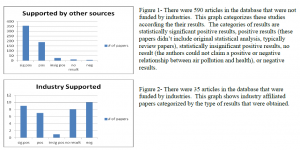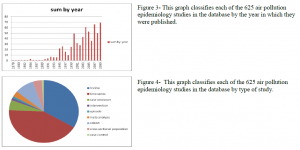Nathan Law and Dr. C. Arden Pope, III, Department of Economics
The main goal of this research project was to discover whether or not results attained in epidemiology studies assessing the increased risk of mortality attributable to air pollution, are influenced by funding source or affiliation of the authors. This study was motivated by public policy debate regarding evidence from ongoing research on the mortality effects of particulate air pollution. New research is constantly being performed and reviewed and changes are being made to improve regulations on air pollution. Well over a thousand research articles have been written and published over the past 25 years on the adverse health effects of air pollution. The majority have reported significant and adverse associations between air pollution and health. There are, however, a minority of articles that report no adverse association between air pollution and health and that reducing air pollution levels only increases monetary costs without any improvements to health. This research project hypothesized that there are differential interpretations of the existence of air pollution effects in articles depending on funding sources and authorship.
In order to address this question, a database of 625 journal articles was compiled. The database was used to determine whether the funding source and affiliation of the author are significantly correlated with the results attained in the articles. The articles compiled in the database were primarily funded by four sources; universities or other educational institutions, research institutions such as the Health Effects Institute, government agencies such as the Environmental Protection Agency, or industries such as the American Petroleum Industry and the American Trucking Association. Many of the industries, such as the two mentioned, have obvious competing financial interests. Tighter air pollution regulations mean enormous costs for these industries. We hypothesized that articles concluding that air pollution does not significantly adversely affect human health are more likely to be funded by one of these industries and that articles with positive conclusions are more likely to be funded by one of the other three funding sources.
We conducted a variety of comparative statistical analyses and found that the funding source and author affiliation are correlated with a higher incidence of papers with negative results. However, the actual number of papers funded by industries in the dataset was smaller than expected. This small sample size led to our results being less significant. We also encountered an issue that that the majority of the articles that were affiliated with industries were written by the same authors. Thus, the probability that an article attained negative results was as correlated with particular authors as it was with industries as a whole.
Our secondary analysis was to determine the trends in pollution epidemiology articles being published. Specifically, how many articles are being published each year and which types of articles are the most frequently published (time series, prospective cohort, reviews, etc.). Figures portraying our results are shown on the following page.
As can be seen, there was a much higher likelihood of reaching negative conclusions or no conclusions for articles funded by industries. 51% of articles that are affiliated with industries reached negative or inconclusive results but only 3% of articles not affiliated with industries reached negative or inconclusive results. These results support the claim that papers funded by industries are more likely to reach negative results and add to the growing evidence of the negative effects of air pollution on mortality.
These figures show a large and continued increase in the number of air pollution epidemiology research articles published each year from 1978-2009 and that the majority of the articles published in this time period were time series analyses and review papers. The increase in articles published indicates that air pollution research continues to be an area of interest among researchers and policymakers.


